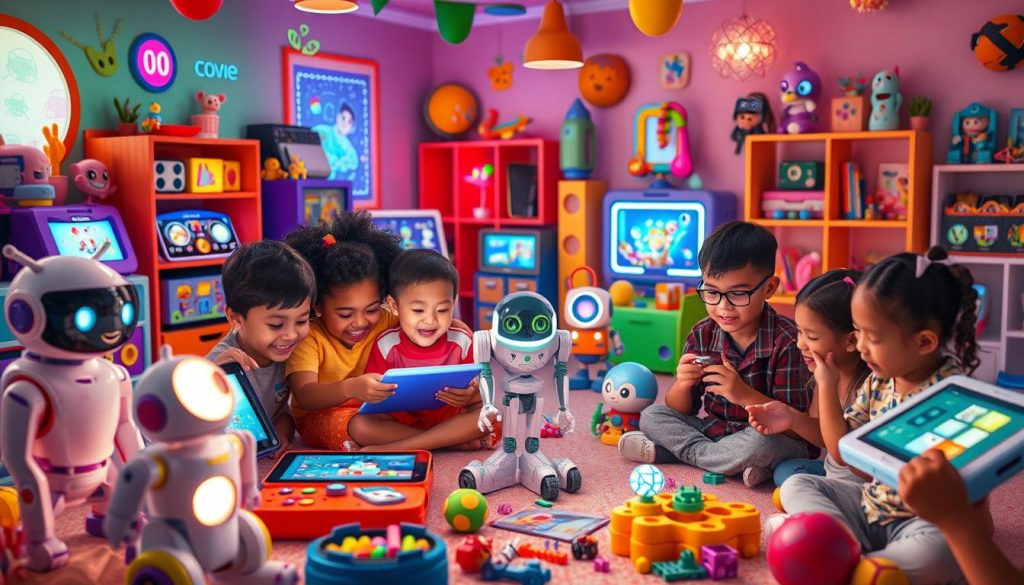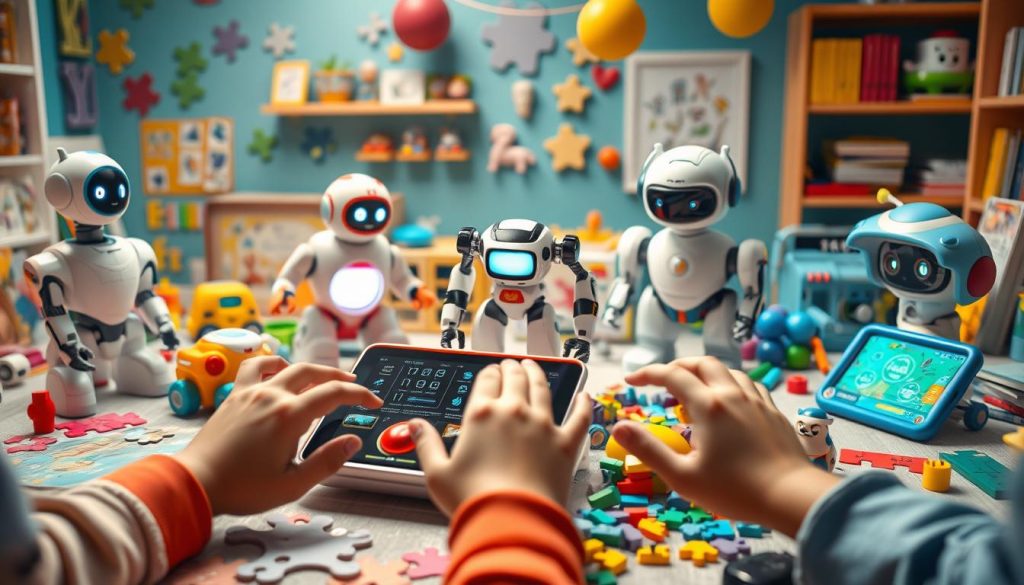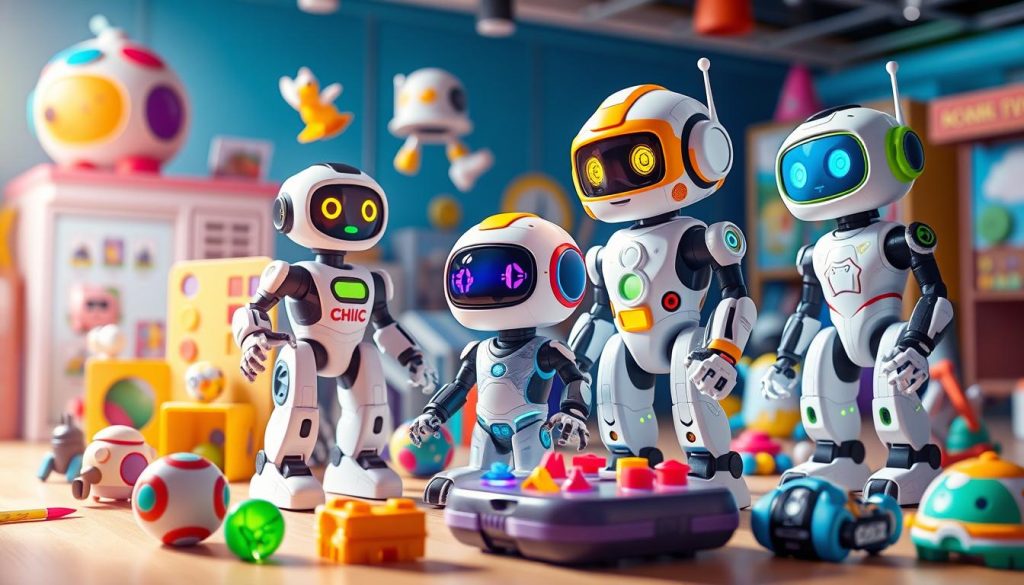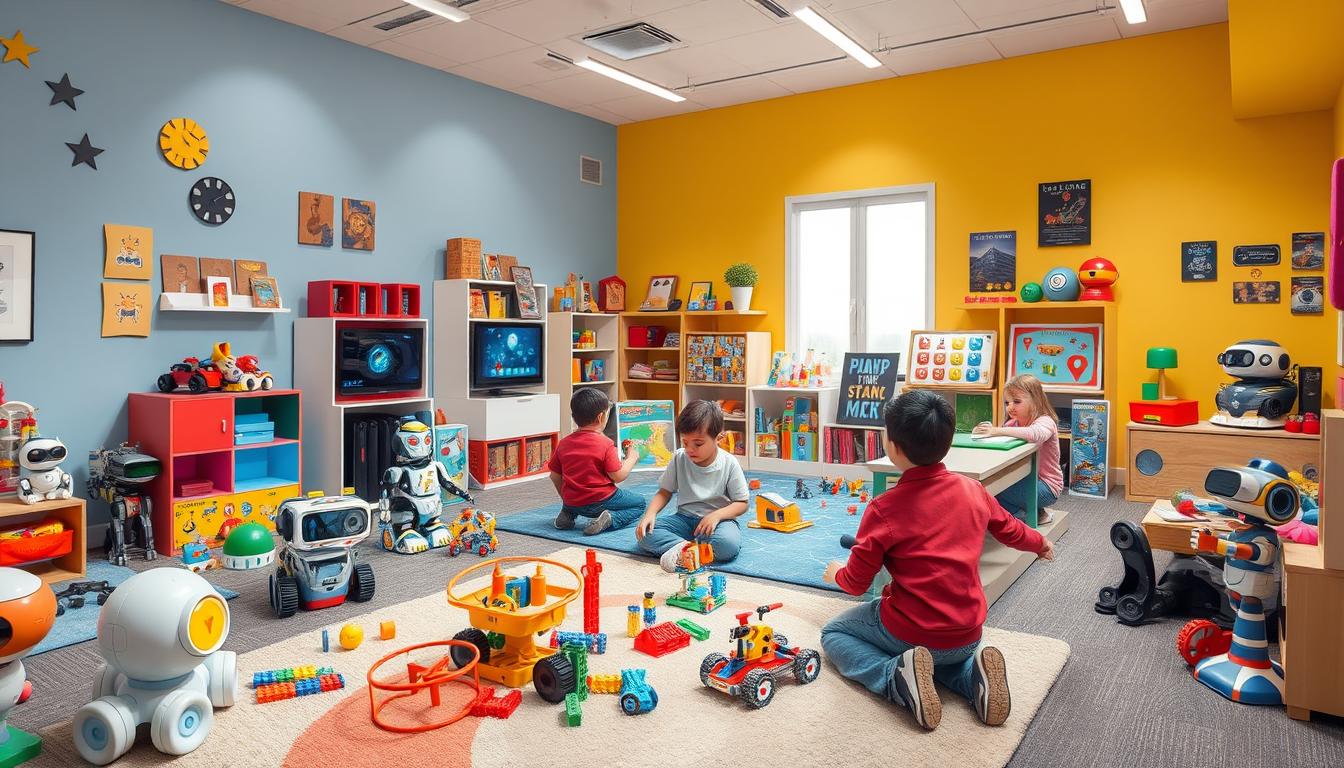As a parent, I’m always searching for new ways to help my child learn. That’s why I love smart toys for kids. These toys are not just fun but also help kids learn in a fun way. Studies, like those from the National Association for the Education of Young Children, show how important play is for kids’ minds and feelings.
When kids play with these toys, they learn important skills. It’s amazing to see how learning can be fun. It makes me excited to see my child grow and learn through play!
Understanding Smart Toys: What Are They?
Smart toys are where play meets technology. They use advanced tech like sensors, apps, and connectivity. This makes them interactive and fun, helping kids learn and be creative.
There are many kinds of smart toys:
- Robotic toys, like Sphero and LEGO Mindstorms, which encourage coding and engineering skills.
- Toys that use augmented reality, such as Osmo, offering immersive experiences that blend digital and physical play.
- Artificial intelligence-powered toys, like Cozmo, that adapt to a child’s behavior and preferences for more personalized interaction.
Each type has unique features that make learning fun. They teach kids to solve problems, work together, and think critically.
The Benefits of Smart Toys for Children

Smart toys offer many benefits for kids, making them a great part of their play. They help improve thinking skills. Kids learn to think critically, solve problems, and get creative.
Studies from the Journal of Educational Psychology show kids who play with smart toys remember things better. These toys make learning fun, not a task. Kids learn at their own speed, which helps them learn on their own.
Smart toys also help kids develop social skills. They encourage kids to work together and share. This helps kids feel part of a group and boosts their self-esteem.
Smart toys mix fun with learning, helping kids grow in many ways. They make sure kids have fun while learning important skills. These skills will help them in the future.
Smart Toys for Kids: Enhancing Learning Through Engagement

Smart toys have changed how kids learn, making learning fun and engaging. They grab a child’s attention and make them think deeply and work together. These toys are key in helping kids grow in all areas.
Interactive Features That Promote Critical Thinking
Smart toys have cool features that make kids solve problems. For example, coding robots like Botley or Sphero let kids be creative and think critically. Kids learn to code and solve puzzles, making learning fun.
How Smart Toys Promote Collaboration Among Children
Smart toys help kids learn to work together, which is great for social skills. Toys like LEGO BOOST and Osmo make kids team up to finish projects or solve puzzles. This teamwork helps kids talk better and have fun learning together.
| Toy Name | Type | Engagement Level | Critical Thinking Skills Fostered | Collaborative Play Opportunities |
|---|---|---|---|---|
| Botley | Coding Robot | High | Logical sequencing, problem-solving | Yes |
| Sphero | Robotic Ball | High | Programming fundamentals, creative thinking | Yes |
| LEGO BOOST | Building Kit | Moderate | Design thinking, engineering concepts | Yes |
| Osmo | Interactive Learning Game | High | Math skills, vocabulary development | Yes |
Choosing the Right Smart Toy for Your Child’s Age Group
Choosing smart toys can be rewarding when I know my child’s developmental stages. Each age has unique abilities, making it key to pick toys that match their milestones. For example, babies need toys that stimulate their senses. Toddlers do well with toys that help them solve simple problems.
With the right advice, I can find toys that engage my child and help them grow. This way, toys become tools for learning and fun.
To guide me, here are some tips:
- Infants (0-12 months) love toys with different textures, bright colors, and soft sounds.
- Toddlers (1-3 years) enjoy exploring with toys like stacking blocks or simple robots.
- Preschoolers (3-5 years) need toys that spark imagination, like role-play sets and interactive books.
- Early school-age (5-7 years) kids benefit from toys that mix technology, like coding games and science kits.
These toys help kids think critically and be creative. When picking smart toys, I make sure they fit my child’s current stage and interests. It’s smart to choose toys that can grow with my child. This way, they can enjoy more complex play as they get older.
Remember, the best toys are those that match a child’s developmental stage and spark their curiosity and joy.
Top Smart Toys for Kids in 2023

This year, many smart toys have caught my eye. They show great educational value and new features. I’m excited to share the top smart toys of 2023. These toys make playtime fun and help kids learn.
Popular Brands and Their Best Products
Some top brands have released amazing smart toys. Here are a few that stand out:
- LEGO: The LEGO Boost Creative Toolbox lets kids build and program their creations.
- Fisher-Price: The Smart Learning Home teaches letters, numbers, and shapes in a fun way.
- Osmo: The Osmo Genius Starter Kit combines physical play with digital learning.
Innovative Tech Features to Look For
When picking smart toys, look for these cool features. They make playtime even better:
- App Integration: Toys that connect to apps offer more learning and track progress.
- Voice Recognition: Some toys have voice recognition for interactive talks.
- AR Compatibility: Augmented reality adds a digital twist to physical play.
How Smart Toys Foster Creativity and Imagination
Smart toys are key in boosting creativity in play. They encourage kids to dive into imaginative play. Here, storytelling and art take center stage.
These toys let children build their own stories and explore new worlds. They make playtime more engaging and fun.
Encouraging Storytelling and Role-Playing
Storytelling toys spark the imagination. LEGO StoryStarter and Clever Storyteller help kids tell stories. They act out scenarios that improve language and emotional smarts.
These toys turn kids into characters in their stories. They help kids develop their storytelling skills. Plus, they offer a chance to work together with friends.
Artistic Activities That Combine Learning and Fun
Art and smart toys mix to create a fun learning experience. Tools like Osmo Genius Starter Kit and Crayola Color Alive make creativity exciting. They help kids grow their artistic skills while enjoying play.
By combining tech and traditional art, these products offer a rich creative experience. Kids get to explore their artistic side in a fun way.
The Role of Smart Toys in STEM Education
Smart toys for STEM are key in teaching kids about science, technology, engineering, and math. They make learning fun and interactive. This hands-on approach helps kids understand complex ideas better, preparing them for future studies.
Building Early Interest in Science and Technology
Smart toys introduce kids to engineering and technology in a fun way. For example, LEGO Boost lets kids build their own machines. This sparks creativity and teaches coding and engineering basics. It encourages kids to explore and learn about STEM early on.
Hands-On Learning Experiences
Hands-on learning is crucial for kids to understand STEM concepts. Toys like Snap Circuits let kids build electrical circuits. These activities are not only fun but also teach problem-solving skills.
By experimenting and seeing the results, kids learn in a real way. They connect abstract ideas to real-life situations. This makes learning more meaningful and fun.
Integrating Smart Toys into Daily Learning Routines
Adding smart toys to my child’s daily learning has changed how we learn at home. It makes learning fun and helps solidify important ideas. With smart strategies and a good learning area, my child has grown in creativity and thinking skills.
Combining Playtime with Educational Goals
I match playtime with learning goals using our smart toys. For example, coding toys help my child solve puzzles, boosting problem-solving. Here are some tips I found helpful:
- Plan themed play sessions on subjects like math or science.
- Set daily challenges that use skills from smart toys.
- Use rewards to motivate learning achievements.
Setting Up a Smart Toy Learning Space
A tidy learning area is key for smart toys to work best. I set up a special corner in our home for focus and creativity. Here’s what I included:
| Element | Description |
|---|---|
| Comfortable Seating | Soft cushions or a child-sized chair for a cozy feel. |
| Flexible Arrangement | Furniture that can be moved for different activities. |
| Bright Colors | Colorful decor to spark creativity and interest. |
| Accessible Storage | Shelves or bins for toys, making clean-up easy. |
| Interactive Wall Space | Whiteboards or chalkboards for brainstorming and solving problems. |
Smart toys in learning routines create a rich learning environment. Making our home a supportive learning space has boosted my child’s interest and effort in learning.
Safety Considerations When Choosing Smart Toys
Choosing smart toys for my kids means keeping safety first. I check the Consumer Product Safety Commission’s guidelines. These rules help ensure toys are safe for kids.
It’s also important to look at the age recommendations on toy packaging. This way, I pick toys that match my child’s age and developmental stage.
Reputable retailers like Toys “R” Us offer great safety tips. They warn about dangers like small parts or loud noises. These can be harmful to young children.
Parental guidance is essential. I need to watch how my child plays with their toys. This helps keep them safe.
ASTM guidelines give me confidence in children’s toys. These standards mean toys have been tested for safety. With safety in mind, I can make sure my kids have a fun and safe play area.

